OUT OF THE INKWELL I am answering some of the emails here, especially as they pertain to previous posts and either ask for clarification, or offer clarification of their own.
TRAVEL DATES: I had speculated on the general time period Walt and his party visited Carlsbad Caverns, but wanted the exact date. Unfortunately, I was off by a year (but right about the trip being World’s Fair related). Enter those most excellent (and supremely omnipotent) folks at the Disney Archives. According to Walt’s travel log he was at Carlsbad Caverns, New Mexico on May 16, 1963. He left for Kansas City on the 17th, and then onto Springfield, Illinois (for meetings on Lincoln, no doubt). He stopped in St. Louis on the 19th, and then to New York City for a General Electric Press Conference on the 20th. He returned home on the 25th. I would like to graciously thank Rob “Part of Your World” Klein and Chief Archivist Dave Smith for going to the trouble of getting this information.
PIRATE CAVERNS: I received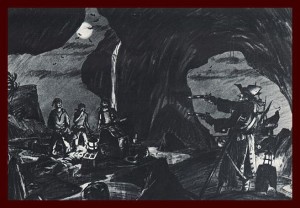 an email from my good friend Todd James Pierce (my hero when it comes to actually getting an interview with an old-timer–he will do anything, now that is dedication!!) about Walt’s visit to Carlsbad: “Enjoyed the articles and photos. I assume you know that these caverns in all likelihood–during this particular trip–were the inspiration for the caverns section of the Pirates of the Caribbean attraction–as there are no limestone caverns at all in the Caribbean (that I know of).”(Rendering at left: WED Imagineering Art Concept For The Pirate Caverns at Disneyland’s Pirates of the Caribbean)
an email from my good friend Todd James Pierce (my hero when it comes to actually getting an interview with an old-timer–he will do anything, now that is dedication!!) about Walt’s visit to Carlsbad: “Enjoyed the articles and photos. I assume you know that these caverns in all likelihood–during this particular trip–were the inspiration for the caverns section of the Pirates of the Caribbean attraction–as there are no limestone caverns at all in the Caribbean (that I know of).”(Rendering at left: WED Imagineering Art Concept For The Pirate Caverns at Disneyland’s Pirates of the Caribbean)
I was not aware of this and Todd and I did some checking. Actually, as it turns out, there are more than 150 limestone caves in Bermuda alone, all containing abundant stalactites and stalagmites. In Barbados there is a famous limestone cave called Harrison’s Cave, that is reputed to be the largest of its kind in the Caribbean, as well as a former pirate hang out. This is why Todd and I are historians, and not geologists. However, with this knew information we continued to chase down the story. Todd added, “I’m pretty sure that the Carlsbad Caverns did play into the creations of the Pirates’ atmosphere–even if they do exist in the Caribbean. I think I can find a reference for you on that. I do remember coming across that in an interview I read or listened to a couple years back. But in terms of timeline, I think it makes sense, too.”
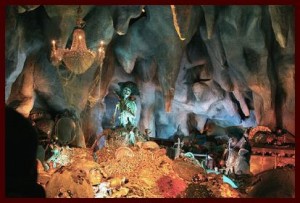 Once we get that information (or if anyone has it), I’ll post it here at the Institute. Recently it seems as if the Pirates of the Caribbean caverns have been on the mind of a lot of folks. D23 did a fantastic Live Chat with Imagineer and Walt Disney Legacy Defender Supreme, Tony Baxter (see D23 Chat With Imagineer Tony Baxter). In that, Tony was asked the specific reason for putting the caverns at the end of Pirates of the Caribbean at Disneyland Paris (Euro Disneyland to us old-timers). Baxter’s response was: “It’s a long story but yes, at DLP we had a chance to correct what we felt was a problem with the original show. The caves at Disneyland filled leftover space. And at Paris, we were able to put that at the end where we all know Dead Men Tell No Tales. It didn’t hurt that Herb Ryman had created a painting years before showing the boats going up into the fort at the beginning of the ride.”
Once we get that information (or if anyone has it), I’ll post it here at the Institute. Recently it seems as if the Pirates of the Caribbean caverns have been on the mind of a lot of folks. D23 did a fantastic Live Chat with Imagineer and Walt Disney Legacy Defender Supreme, Tony Baxter (see D23 Chat With Imagineer Tony Baxter). In that, Tony was asked the specific reason for putting the caverns at the end of Pirates of the Caribbean at Disneyland Paris (Euro Disneyland to us old-timers). Baxter’s response was: “It’s a long story but yes, at DLP we had a chance to correct what we felt was a problem with the original show. The caves at Disneyland filled leftover space. And at Paris, we were able to put that at the end where we all know Dead Men Tell No Tales. It didn’t hurt that Herb Ryman had created a painting years before showing the boats going up into the fort at the beginning of the ride.”
I printed Carl Barks resignation letter here at the Institute and in that post I mentioned that Michael Barrier would be the ultimate resource for any information on the letter and its history. I was right. And true to his nature, Mike came through:
“I was the person who located that letter, but long after my book on Barks was published. It was in the Disney Archives’ files of Walt’s interoffice correspondence (a much richer trove than his correspondence with the outside world, at least for my purposes at the time). I remember calling the letter to Dave Smith’s attention, and I believe he subsequently filed the letter with other Barks letters and such (which I saw and some of which I copied on one of my very first visits to the Archives–I still have the old slick photocopies). I wrote a piece about finding the letter, and about the circumstances surrounding Barks’s resignation, that appeared with a reproduction of the letter in Walt Disney’s Comics No. 605, October 1996. (Barks’s letter was also reproduced in Uncle Scrooge Adventures in Color No. 4, in June 1996. The letter was typewritten, by the way, not handwritten.)”
So for the “Rest of the Story” (with apologies to Paul Harvey), I recommend you seek out the comic book. Moreover, if you have not been following the essays by Michael on Walt and the Ivy League and on Dumbo, you should. Highly stimulating history, with the typical Barrier “overkill” (in his own words). See his site at: Michael Barrier.
Longtime friend Kai Verbarg from Germany wrote me the following: “This is just to let you know how excited I am about your new blog! It hardly seems possible, with all the Disney-themed blogs out there, that you could find and post fresh stuff, but from what you’ve posted so far, that is exactly what you’re doing. One article or post that I’d love to see would be on the involvement of Pepsi-Cola and Disney at the 1964 World’s Fair. There’s one item I THINK I saw you mention in Persistence of Vision once, namely, a character called “Pepsi Maid” or something, only I haven’t been able to scare up an image of that anywhere…I seem to recall you published an image of the maiden in a POV issue (which I’d have to pull out of my safety deposit box). Well, if not you, then who would have something on this?”
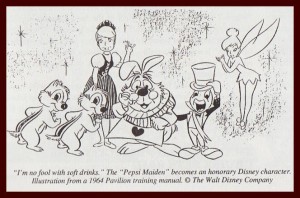 Thank you Kai for your kind words and continued support. In my extensive piece on Walt and the 1964 New York World’s Fair in POV #6/7, I did have a “chapter” on Pepsi and hope to add to it and post bits and pieces here at the Institute. And yes, I did post one image of the Pepsi Maiden with that article, but in the last fifteen years I have found a few more. The idea was largely that of Van France who had the responsibility of writing the Disney training manuals (aka, Standard Operating Procedures) for those working at the Fair. (Image at Left: The Pepsi Maiden from POV #6/7)
Thank you Kai for your kind words and continued support. In my extensive piece on Walt and the 1964 New York World’s Fair in POV #6/7, I did have a “chapter” on Pepsi and hope to add to it and post bits and pieces here at the Institute. And yes, I did post one image of the Pepsi Maiden with that article, but in the last fifteen years I have found a few more. The idea was largely that of Van France who had the responsibility of writing the Disney training manuals (aka, Standard Operating Procedures) for those working at the Fair. (Image at Left: The Pepsi Maiden from POV #6/7)
The following image is the cover of one of several different training manuals done by Disney for It’s A Small World at the Fair (each area needed a separate manual). This image includes Disney ambassador Jiminy Cricket (used extensively in training materials from the Fair) and a Pepsi Maiden.
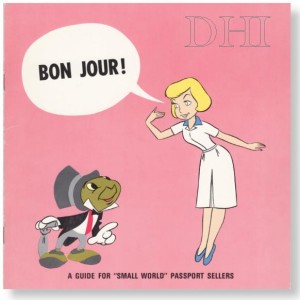 The other Disney ambassador that was used extensively in the Fair training manuals (more so than Jiminy) was Tinker Bell. In just one It’s A Small World books, she makes over a dozen appearances inside to assist those in learning the Disney magic. In this particular book, she actually takes on the persona of a Pepsi Maiden.
The other Disney ambassador that was used extensively in the Fair training manuals (more so than Jiminy) was Tinker Bell. In just one It’s A Small World books, she makes over a dozen appearances inside to assist those in learning the Disney magic. In this particular book, she actually takes on the persona of a Pepsi Maiden.
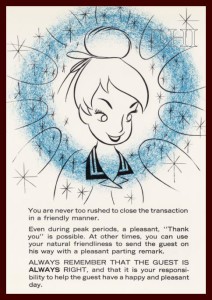 More “Out of the Inkwell” Next Journal
More “Out of the Inkwell” Next Journal
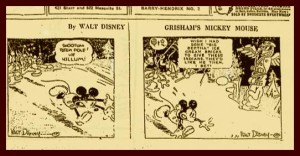 STOLEN ORPHAN’S MILK To those that actually follow my strange musings here at the institute (DHI Reference: The Mystery of “Grisham’s Mickey Mouse”), I offer another teaser of things to come, and to who actually stole the orphan’s milk! In this new clue, we see Mickey Mouse, in his former politically uncorrect Gottfredson incarnation, needing Big Bertha Bricks to placate the Indians (did they steal the Orphans’ Milk?). Will Grisham come to the rescue? Will Mickey live to see another adventure? What exactly is a “Big Bertha Brick”? Keep tuning in to the Institute to see how this mystery turns out!
STOLEN ORPHAN’S MILK To those that actually follow my strange musings here at the institute (DHI Reference: The Mystery of “Grisham’s Mickey Mouse”), I offer another teaser of things to come, and to who actually stole the orphan’s milk! In this new clue, we see Mickey Mouse, in his former politically uncorrect Gottfredson incarnation, needing Big Bertha Bricks to placate the Indians (did they steal the Orphans’ Milk?). Will Grisham come to the rescue? Will Mickey live to see another adventure? What exactly is a “Big Bertha Brick”? Keep tuning in to the Institute to see how this mystery turns out!
DISNEY & HIRSCHFELD-“An Artist Contests Mr. Disney”
(DHI Reference: Walt Caricatures)
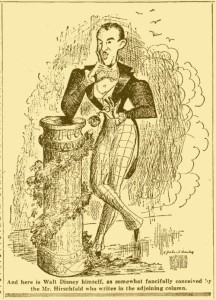
Back on the DHI Walt Disney Birthday Celebration I wrote about caricatures of Walt, and mentioned one by Al Hirschfeld, the “line king.” I had intended on posting it shortly after the Birthday celebration, but this became an issue when it could not be readily found; and searching through tens of thousands of newspaper clippings here at the Institute to find said caricature appeared to be a formidable task. Fortunately, an unexpected rescue came in the form of my eleven-year old son and the question, “Dad, can I do Disney research too?” What resulted was the Institute’s first internship and the discovery of what I promised to share with DHI readers over four months ago.
The caricature, and accompanying Hirschfeld article titled “An Artist Contests Mr. Disney,” appeared in the New York Times on January 30 1938. Having been removed from the article for over a decade, I did not remember the less-than-flattering nature of the piece. It was guised under the pretense of reviewing Snow White and the Seven Dwarfs, and the famed caricaturist was not very fond of Walt’s newest creation (one of the few that felt this way, I might add).
I’ve learned more about Hirschfeld in the intervening years, including his use of the line to express his feelings towards an individual, whether to the positive or negative. There is more to Hirschfeld’s line than a caricaturist’s exaggeration, there is editorial content. Because of this, I did not want to post the caricature by itself, especially when a closer examination suggests a rather uncomplimentary tone towards Walt. The caricature comes off as a bit of a hick-ish, foppish dandy; beady eyes, buck teeth, tux, wilted rose, and all. Not lost on me was the pedestal, surely a commentary on the artistic Sainting of Walt during the thirties (and of course, in Hirschfeld’s vision, Walt is decidedly not on a pedestal). Moreover, the garland on the pedestal further illustrates Hirschfeld’s perceived adulation of Walt ( garland was a mark of honor and a tribute). Based on this, I felt a bit of my own editorial commentary might be appropriate.
Hirschfeld’s objections to Walt’s new art form are the “attempts at realism.” A given, I guess, considering his own work and fame were founded upon heavily stylized art. Hirschfeld takes particular aim at the human characters, especially Snow White, the Evil Queen, and Prince Charming, referring to the latter as the “cardboard lover.” He states that art–at least his idea of art–is of a well directed pen line and should not “be confused with the gingerbread realities of a Snow White.” In Hirschfeld’s world, Disney’s realism belongs to the “oopsy-woopsy school of art practiced mostly by etchers who portray dogs with cute sayings” (an artistic slam if ever there was one). Moreover, he directly assaults Ms. White’s realism by declaring that “with her full complement of fingers and fingernails, eyelashes, one dimensional head, bare arms without solidity and uninventive neck” she is nothing more than an “anatomic automaton.” Interestingly, no mention was made of the rouge that was uniformly and painstakingly applied to each cel by the talented Disney Ink and Paint Department (too realistic, perchance?).
Hirschfeld’s disdain w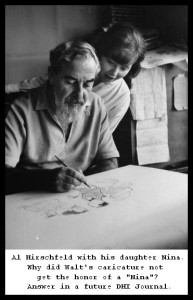 ith the human characters is not, however, transferred to the dwarfs. For the seven little men he finds a soft spot: “Much praise has been written about the Dwarfs by competent reviewers, and I enthusiastically join in their huzzahs. These inspired gnomes, with their geometrical noses, flexible cheeks, linear mouths and eyes, highly stylized beards, costumes and three fingers lend themselves to articulation because of the tremendous magic of well directed lines.”
ith the human characters is not, however, transferred to the dwarfs. For the seven little men he finds a soft spot: “Much praise has been written about the Dwarfs by competent reviewers, and I enthusiastically join in their huzzahs. These inspired gnomes, with their geometrical noses, flexible cheeks, linear mouths and eyes, highly stylized beards, costumes and three fingers lend themselves to articulation because of the tremendous magic of well directed lines.”
After dissecting the characters, Hirschfeld offers some pointed words for the movie’s surroundings: “A specific example of this contagious influence may be observed toward the end of the film. Prince Charming lifts Snow White and places her on his white charger. The horse is badly drawn because Snow White and Prince Charming are badly drawn. This scene, whose only virtue is its consistency, could not avoid being bad all the way through.”
The article is not all doom and gloom. Hirschfeld does offer high praise to Walt’s alter-ego: “I do not mean to imply that Disney has offered us nothing new. I merely wish to point out that Mickey Mouse is great art and not a clever novelty, and Disney should not underestimate the genius of his original invention.” The cantankerous caricaturist admonishes Walt to return to what he does best, to once again become “tuned in” to the “right” (read: Hirschfeld’s vision) form of artistic expression; for in his mind, Snow White is merely “corrupting Disney’s style.” This type of sentiment does not surface until after World War II, when Walt, the former darling of the intellectual and artistic set in the thirties, is accused of selling out to commercialism. Better to be poor and artistic than rich and popular. True irony exists here, for the Disney’s were much better off financially in the thirties when they were “artistic” as compared to the forties and fifties when they were “commercial.”
Hirschfeld also takes umbrage to Walt’s perceived lack of originality in the film based on the reuse of gags: “I laughed loud and long when Chaplin in City Lights swallowed a policeman’s whistle and hic-coughed a high wheeze. When Dopey, an excellently designed dwarf, swallows a cake of soap and burps bubbles it is just as funny, but no funnier.”
Just when you think artist Al has finished his critique, he once again revisits his dislike of realism in animation (one wonders what his thoughts towards Fantasia were?). In his mind the evolution of animation towards realism is heresy. Indeed, he takes a jab at Walt referring to him as a “mediocre genius” simply because “he is working toward realistic photography” which is a ghastly vision and an “innocuous departure” from his early genius at animation. What could ensue if Walt does not return to this former glory, according to Hirschfeld, is that this new vision represented in Snow White “could once more revolutionize the motion picture industry by reverting to human beings” rather than the wonderment of caricatures. The end would therefore be just “taxidermy rather than graphic art.”
In the final paragraph Hirschfeld shows us the lenses in which he has used to view Snow White and the Seven Dwarfs: “My primary interest is the proper appreciation of caricature and its allied arts.” Had he started by sharing his perspective-as all English professors preach as gospel for writing an editorial–he might not have come off so harsh. Yet, even w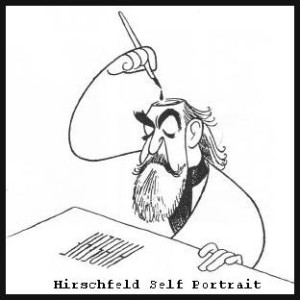 ith this confession, which has the feel of softening the blow, he shows us that he believes himself to be the arbiter of art, or as he states in his closing statement the “voice of reason” from “one craftsman to another.” It reeks a bit of perhaps some professional jealousy, with a large dose of sermonizing–one artist explaining the vision to another artist, and why the vision is best and should be returned to. Very peculiar coming from an artist–any artist–because the very nature of art suggests no right or wrong way. The vision of an artist should be their vision, and not what someone else thinks it should be.
ith this confession, which has the feel of softening the blow, he shows us that he believes himself to be the arbiter of art, or as he states in his closing statement the “voice of reason” from “one craftsman to another.” It reeks a bit of perhaps some professional jealousy, with a large dose of sermonizing–one artist explaining the vision to another artist, and why the vision is best and should be returned to. Very peculiar coming from an artist–any artist–because the very nature of art suggests no right or wrong way. The vision of an artist should be their vision, and not what someone else thinks it should be.
Hirschfeld brings it to a close with one final parting poke: “And so, Mr. Disney, it is with regret and some anger that I feel you have made the biggest needle-point ever devised by man.” To which, I close with…And so, Mr. Hirschfeld, it is with some regret and happiness that I report Walt did not take your artistic advice. In fact, history has demonstrated that your artistic vision was not applicable, at least where Mr. Disney is concerned. Walt did amuse and amaze us with the vision you approved of–and does to this day, after all, is Mickey Mouse still not popular? Walt also showed his vision of full-length animated features was correct. Oh, and also live-action films. Oh, and also something we call theme parks. Oh, and ….
PERSISTENCE OF VISION I mentioned here at DHI back in November in response to a comment (See: Comments) about the disappearance of POV. It was obviously not my plan, but it is the plan that life had for me. Believe me, illness is no fun, I would much rather have just continued on with POV. Still, if there is anybody that feels like they did not get their money’s worth, or wish to just take a pound of flesh from me (or even write me an email sharing your thoughts), please do so. I will try to make it right in whatever way I can. Much of what I planned for POV I will be sharing here at the Institute. If there is any way in the future to publish again (with all the new technology available), then hopefully the stars will be right (but it is currently not in my plans). My number one task is to preserve the 250-plus interviews I did through the work from POV (of which, your support in the early years was crucial–thank you). In the coming months here at DHI, I will be trying to regularly list items in the DHI Museum Store (mostly historical items, books, and so forth). If I can offer you a percent off to equate to any loss you feel, or make amends in another way, just let me know. Thank you.
THE DISNEY HISTORY INSTITUTE BOOK STORE The first listing of historical items and books will be put up at the DHI Book Shop link by Friday. Moreover, I will be attempting to put up another ten to twenty items a week as things sell. There will be everything from extremely rare Walt Disney historical items to books (rare, out of print, and more common tomes). I will also have autographs and signatures from those that worked with Walt. The purpose is to help support the Institute, as well as to assist in paying off some massive medical bills. I am not selling any of the Institute’s collection, but doubles and extras. I am also interested in trading for historical items I may not have. Please feel free to email me with anything you might have for trade.
FINALLY … THE PASSING OF A DISNEY LEGEND It is with deep sadness that I recognize the passing of a good friend, and someone who was instrumental in my Disney history career. By now, you have all heard of the passing of Fess Parker at age 85. Because of the power issues here, I was two days behind the world in learning of our loss.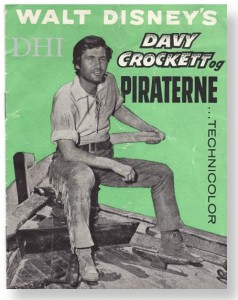
I first met Fess Parker in 1991 at the Disney Legends Ceremony. I was in attendance as a member of Ken Anderson’s family; Ken was also receiving a Disney Legends award that day. The Studio had set up a special breakfast area for the honorees and their families. I was in seventh heaven and totally oblivious to my surroundings (some of which included the likes of Carl Barks, Sterling Holloway, Fess Parker, Julie Andrews, Claude Coats, and so forth). After finishing our Mickey pancakes and scrambled eggs, Ken stood up and said to me, “Come on, I want you to meet someone.” Ken walked over to a giant of a man (I’m 6’2″ and he dwarfed me) and said, “Fess, I want to introduce you to my son.” I could not have gone any higher in the stratosphere at this point, even with a Tomorrowland Jet Pack. It was a Disney historian’s dream.
Fess was gracious. Fess was always gracious! I asked if I could do an interview with him, and he happily agreed (being with Ken’s family helped, I’m sure).
Two years later over Memorial Day weekend I went up to his Winery and sat down with him for a wonderful series of interviews. Fess was beyond gracious! We quickly discovered a common interest in history. I told him I was truly interested in all history, but especially Disney history. He asked me if this is what I really wanted to do with my life. More than anything, I responded. At that point, I received a good dose of fatherly advice (I can not explain it any other way). It was about following my dream and sticking to what I have passion for. If Disney history was it, do it better than anyone else and always devote yourself to it. To this day, I have never forgotten his words. When I told him I was interested in oral history and wanted to do as many interviews as I could before everyone was gone, he graciously (Fess was as gracious as they come) opened his address book and personally called a dozen or so folks from his days at Disney that he felt I should talk to. This resulted in an article for Persistence of Vision, and ultimately lead to my first book, The Davy Crockett Craze.
The one thing that I learned over the years of my association with Fess Parker, is that he was the very personification of Davy Crockett; a case of life imitating art, if ever there was one. But in this instance, Fess was no imitation, he was the real thing. His only shortcoming was that he only gave us 85 years, and it wasn’t enough.
In the upcoming weeks I am going to present a Disney Fess Parker tribute here at the Institute. Often times a tribute is for those who are left behind–for those who mourn the loss of a loved one. If this is true, then this DHI tribute is for Baby Boomers everywhere, because on March 18th, we all lost somebody we loved a lot. The void that is left with us after his passing, will hopefully be filled with the happy memories and stories that I will be sharing in this tribute. Please stop back in to the Institute in the coming days to celebrate the life of Fess Parker.

Recent Comments